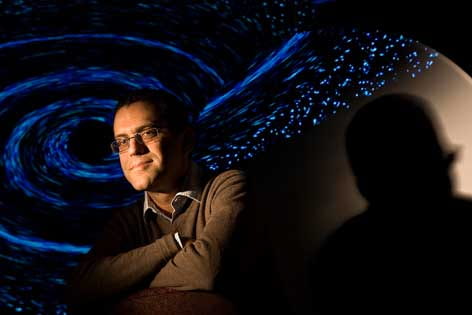Black hole patrol
UC Irvine’s Aaron Barth, physics & astronomy associate professor, will speak on “Supermassive Black Holes in Galaxies” as part of the 2009-10 Discover the Physical Sciences Breakfast Lecture Series.

Giant black holes – among the strangest and most fascinating objects in the universe – exist in the centers of most large galaxies, including the Milky Way. And their role in the formation and evolution of galaxies is the subject of extensive astrophysical research.
UC Irvine’s Aaron Barth, physics & astronomy associate professor, will speak on “Supermassive Black Holes in Galaxies” as part of the 2009-10 Discover the Physical Sciences Breakfast Lecture Series, sponsored by the School of Physical Sciences. Free and open to the public, the event will take place 7:30-9 a.m. Tuesday, Nov. 24, at the Student Center. Reservations are requested at 949-824-7252 or events@ps.uci.edu.
Here, Barth answers some questions about black holes in advance of his lecture:
Q: What types of black holes exist?
A: Two main categories of black holes have been observed. Stellar-mass black holes are the remnants of individual stars that originally were many times more massive than the sun. We can detect them when they’re in binary systems, with another star rapidly orbiting the black hole. Supermassive black holes are found in the centers of galaxies and have masses that are millions to billions of times greater than that of the sun. These black holes accumulated their enormous masses over billions of years by swallowing up gas, stars and even other black holes. When gas is spiraling toward a black hole, it heats up and radiates tremendous amounts of energy. Such “active” black holes that are consuming large quantities of gas are called quasars, and they are among the most luminous objects in the universe.
Q: What do scientists hope to learn about supermassive black holes?
A: We’d like to learn how they first formed in the early history of the universe. We don’t know whether they initially were stellar-mass black holes and grew rapidly by swallowing up gas and merging with other small black holes, or whether they formed through the catastrophic collapse of very massive gas clouds. Researchers also want to understand the growth rate of the entire population of black holes over the history of the universe and how energy emitted by quasars influences their host galaxies. The physics of how black holes grow is enormously complex, and we need better insight into how this works and how energy is radiated away during the process. We’d also like to carry out accurate measurements of the masses of black holes in the centers of nearby galaxies to learn how much of the universe’s mass is locked up inside black holes.
Q: Why is it important to make these discoveries?
A: It’s becoming increasingly evident that supermassive black holes have played an important role in the formation and evolution of galaxies. Black holes probably have strongly influenced the rate of star formation in galaxies, and we’d like to understand this in detail. Beyond that, black holes are intrinsically fascinating objects because we can use them as laboratories to study the behavior of matter under conditions of extremely strong gravity and study exotic phenomena like black hole mergers.
Q: How do astronomers find supermassive black holes?
A: When a black hole is active and swallowing up lots of matter, it shines brightly and is easily detected. These quasars have properties very distinct from normal stars and galaxies, and this makes it possible to find them even at very large distances. Within the centers of nearby galaxies, where black holes are mostly dormant, we can try to “weigh” an invisible black hole by measuring the motion of stars or gas clouds orbiting it. By determining the speed of objects orbiting the center of a galaxy, we can measure the mass of a black hole even if we can’t see it directly.
Q: How are you researching black holes in your laboratory?
A: Unfortunately, limited research budgets and safety regulations don’t permit us to construct or study supermassive black holes in a laboratory. So we do the next best thing: We observe them with telescopes. My research group uses data from the W.M. Keck Observatory in Hawaii, Lick Observatory in California, and NASA facilities like the Hubble Space Telescope, Spitzer Space Telescope and Chandra X-ray Observatory to study the properties of black holes in the centers of nearby galaxies.
Q: What interests you about astronomy?
A: The night sky contains an amazing amount of information about the history of the universe and exotic objects such as black holes. It’s tremendous fun trying to capture and decipher some of that information, and it’s great to have a job where I can spend my time thinking about these things.